If you’re feeling a bit overwhelmed by the various options within Oracle Primavera, you’re certainly not alone. Many professionals encounter similar challenges while trying to navigate the complexities of Oracle’s project scheduling solutions. This particularly pertains to choosing between staying on Primavera P6 EPPM or moving to Oracle Primavera Cloud.
Our team conducted a poll among our LinkedIn followers to gain a clearer picture of our community’s familiarity with these tools. The question posed was: What best describes your current understanding of P6 EPPM versus Oracle Primavera Cloud? Here’s what we discovered:
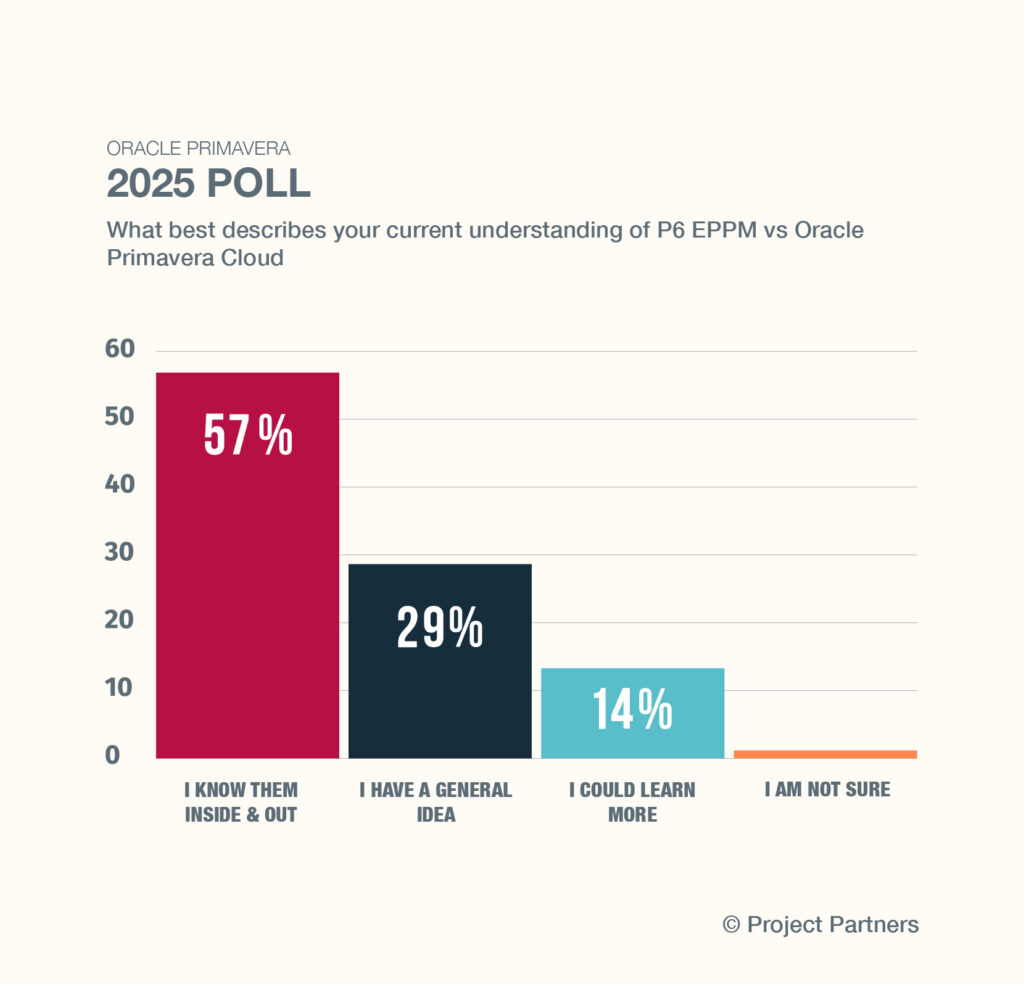
In this blog, our team of experts shares tailored guidance and insights that will help you uncover the most suitable Primavera scheduling solutions for your project needs and organizational objectives.
The Ins and Outs Oracle Primavera P6 EPPM
For over three decades, Oracle Primavera P6 Enterprise Project Portfolio Management (EPPM) has been recognized as the leading standard in project scheduling and management. Known for its comprehensive functionality, P6 provides a variety of user interfaces and deployment configurations designed to accommodate diverse needs, including:
- P6 Professional: which serves as a comprehensive desktop application
- P6 EPPM: a powerful browser-based platform designed for enterprise-wide accessibility
- P6 Team Member: a versatile solution available both in a web format and as a mobile application, which facilitates real-time status updates and time reporting for project teams.
The History of P6 EPPM
In 2008, Oracle Corporation strategically acquired Primavera and subsequently designated P6 EPPM as its flagship product within the project management suite. Since that acquisition, the core functionality of P6 EPPM has not undergone any groundbreaking changes. Oracle has maintained a commitment to the platform by consistently investing in enhancements, updates, and support services.
This ongoing investment indicates that P6 EPPM remains a vital component of Oracle’s offerings, making it highly unlikely for Oracle to phase it out in the foreseeable future. Thus, for those who rely on P6 EPPM for their project management needs, rest assured! You still have a solid foundation for continued use and investment in the platform.
What are P6 EPPM’s Advantages?
Choosing P6 EPPM offers numerous advantages that can significantly enhance project management effectiveness. Here are some key reasons to consider this platform:
- Sophisticated Schedule Management: P6 EPPM excels in creating, updating, and analyzing project timelines. This allows project managers to maintain control and make adjustments as needed to ensure timely delivery.
- Comprehensive Resource Management: The resource management module allows for optimal allocation of personnel and materials, ensuring projects are well-staffed and equipped. This helps maximize productivity and minimize wastage.
- Earned Value Management (EVM): This feature provides essential insights into project performance, allowing teams to measure progress against the budget and schedule. Real-time variance identification helps in proactive decision-making to stay on track.
- Risk Management Tools: The integrated risk register enables systematic tracking and management of potential project risks. This empowers teams to identify and mitigate issues early, reducing the likelihood of project disruptions.
- Advanced Reporting Capabilities: P6 EPPM supports detailed reporting through BI Publisher and Report Writer, delivering customizable reports that cater to various stakeholder needs. This ensures clear communication and transparency throughout the project lifecycle.
- Interactive Visualization Tools: The platform includes advanced visualization features like interactive dashboards and portfolio analysis. This allows users to monitor key performance indicators easily and make informed, data-driven decisions.
- Scalability for Complex Projects: P6 EPPM is designed to handle projects of all sizes and complexities, making it a suitable choice for diverse industries and project types.
By utilizing P6 EPPM, organizations can enhance their project management capabilities, drive efficiency, and ultimately achieve greater project success.
P6 EPPM Screenshots
Below are a few screenshots of the features provided by Primavera P6 EPPM:
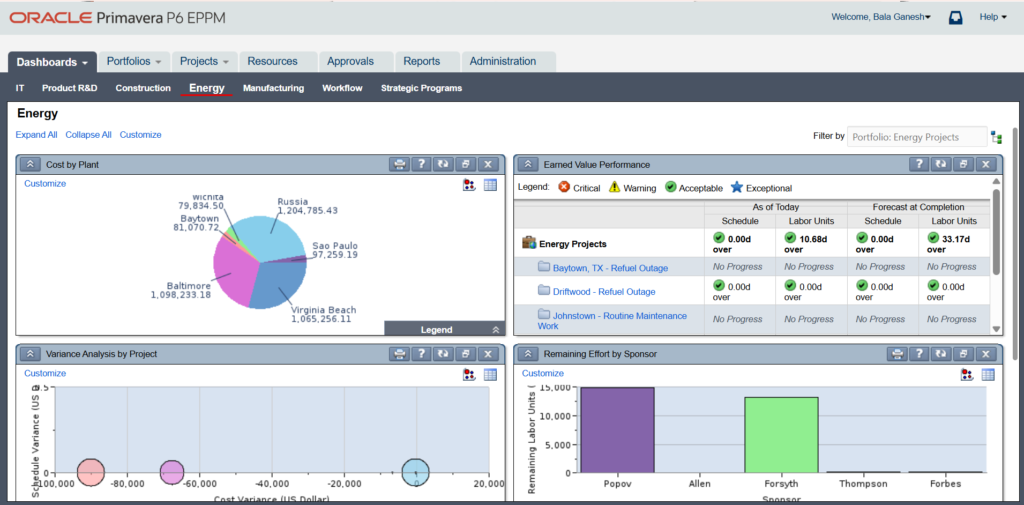
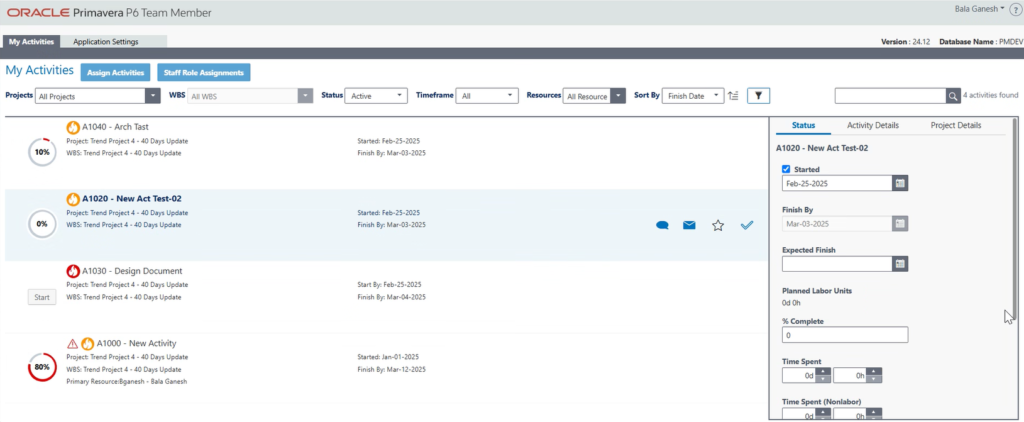
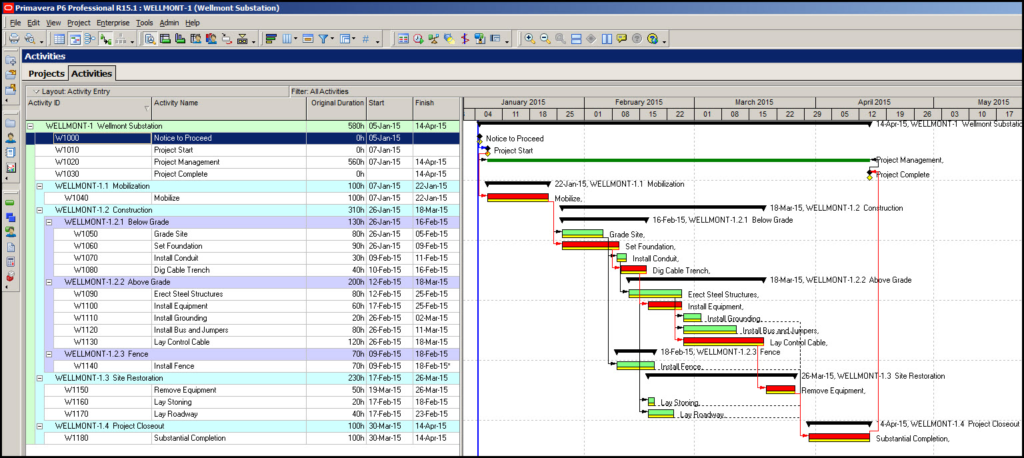
What’s the Hype with Oracle Primavera Cloud?
Oracle Primavera Cloud (OPC) is an innovative solution in project and portfolio management, specifically designed to meet the challenges of today’s complex project environments. While it builds on the core scheduling and resource management features of P6 EPPM, OPC elevates its functionality with a range of features aimed at optimizing project delivery.
Lean Schedule Management
One of the standout features of the OPC platform is its Lean Schedule Management system. It is meticulously designed to optimize efficiency and reduce waste throughout the project scheduling process. This system not only streamlines workflow but also allows for the effective allocation of resources. This ensures that teams can focus on delivering value without unnecessary delays.
Risk Management
Central to OPC’s capabilities are its comprehensive Risk Management tools, which include sophisticated Monte Carlo Analysis functionalities. This advanced capability empowers project managers to assess potential uncertainties and variabilities within their projects. By simulating a range of possible outcomes, managers can make strategic decisions grounded in robust data, ultimately increasing the likelihood of project success.
Reporting and Dashboards
OPC is further enhanced by its dynamic dashboards and reporting tools, which provide real-time insights into key project performance indicators. These insights facilitate timely, data-driven decision-making, enabling teams to swiftly identify issues and adjust their strategies as needed. The platform also incorporates customizable Workflows and Forms that effectively streamline processes, fostering seamless collaboration among project teams and enhancing overall productivity.
Schedule Comparison
Additionally, OPC offers powerful Schedule Comparison tools for those interested in exploring various project scenarios. These tools allow users to create, analyze, and refine baselines and perform detailed “What If” simulations. Such capabilities enable comprehensive planning and allow teams to anticipate challenges and opportunities proactively.
Resource Allocation
Furthermore, OPC excels in crucial areas such as Capital Planning, Portfolio Management, and Cost Management. By empowering organizations to allocate resources effectively and adopt informed investment strategies, the platform helps maximize returns on investment while minimizing financial risk. Overall, OPC stands out as a comprehensive solution that prioritizes efficiency, collaboration, and strategic foresight in project management.
OPC Screenshots
Overall, Oracle Primavera Cloud positions itself as a comprehensive solution, ideally suited for organizations seeking to elevate their project management practices to new heights. Below are a few screenshots of the features provided by OPC:
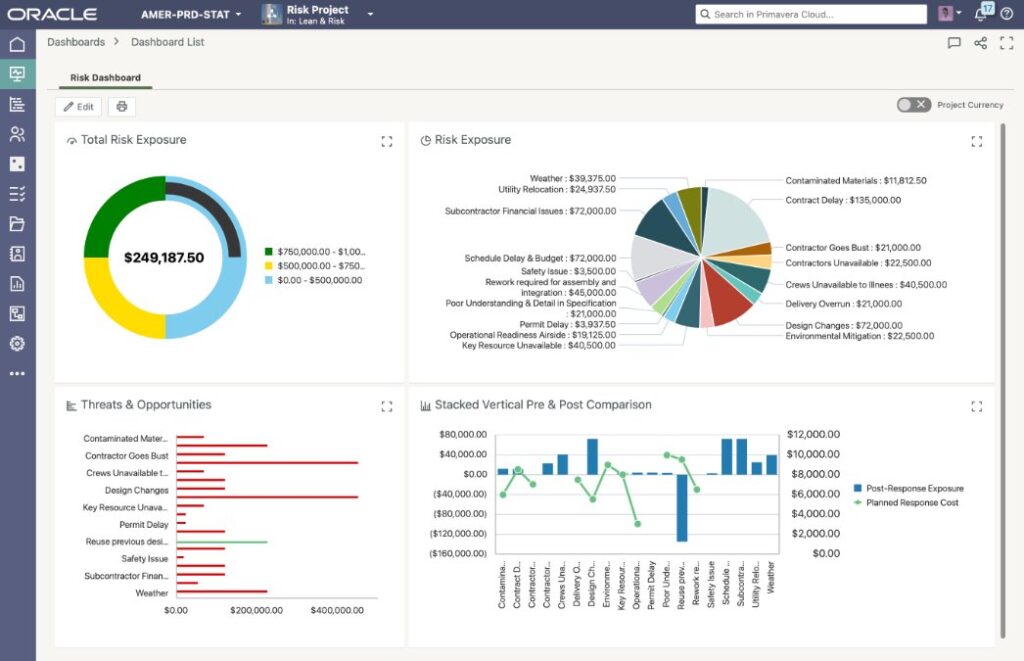







OPC vs. P6 EPPM Considerations
For the past five years, OPC has been operational. Nevertheless, it has only recently undergone enhancements that (in our experience) enable it to effectively serve as a superior alternative to P6 EPPM for most organizations. We highly recommend OPC to any organization looking for a comprehensive scheduling and project management solution.
Architectural Differences
Due to its architectural differences, OPC may not be the best fit for large-scale or mega projects. P6 EPPM is built on a relational database architecture, typically using Oracle Database. Oracle Database is optimized for handling millions of activities, logic ties, and work breakdown structure (WBS) levels. In contrast, OPC is a cloud-native Software as a Service (SaaS) application designed for flexibility and modern interfaces. However, it is not yet optimized for extremely large critical path method (CPM) schedules.
You can think of it this way:
- P6 is like a powerlifter: incredibly powerful and capable of handling heavy loads.
- OPC is like a gymnast: strong and agile but built for different tasks.
Both tools are effective, but they are designed for different types of projects.
How the Cloud Model Impacts Your Organization
With all that said, one of the standout advantages of OPC is its alignment with a cloud-only strategy, as it is exclusively delivered through a subscription model. This approach eliminates the need for extensive IT support, as no cumbersome software installations are required. Users benefit from seamless integration and automatic updates, with new software releases being rolled out on a monthly basis. Our observations indicate that Oracle is making significant investments in OPC’s development, and many of the new features introduced appear to be directly influenced by user feedback, ensuring that the tool evolves in line with user needs.
Accessible Training
OPC boasts a robust array of built-in training modules designed to empower users to make the most of the platform. By simply clicking on the “Help” option, users can seamlessly access a wealth of resources, including instructional videos and comprehensive user guides. This feature not only facilitates a rapid understanding of the software’s functionalities but also enhances the overall user experience, making it simpler and more efficient for teams to adopt and utilize OPC effectively.
A Side-by-Side Comparison
If you are still determining if P6 EPPM or OPC suits your organization and its users, here are some key feature comparisons between the two products for your consideration:
| Area | Feature | Oracle Primavera Cloud | Oracle Primavera P6 EPPM |
| Schedule Management | Critical Path Method | Yes | Yes |
| Schedule Management | Lean Scheduling | Yes | No |
| Schedule Management | Schedule Comparison | Advanced | Basic |
| Progress Reporting | Mobile Status Updates | Yes | Yes |
| Cost Management | Cost Loaded Schedules | Yes | Yes |
| Cost Management | Cost Sheet: Budgets, Actuals Tracking | Yes | No |
| Resource Management | Role and Resource Assignments | Yes | Yes |
| Reporting | User Created Advanced Reporting | Yes | No |
| Risk Management | Monte Carlo Analysis | Yes | No |
| Feature | Forms and Workflows | Yes | No |
| Usability | Number of Activities* | Small-Medium Project Schedules* | Large Project Schedules* |
| Feature | Advanced Gantt Chart Printing | No | Yes |
| Feature | Export to UN/CEFACT Format 6, IPmdar, or CPP Formats | No | Yes |
| Pricing | Minimum Users | 5 | 25 |
| Pricing | Model | Subscription Only | Subscrption |
| Upgrades | Release Schedule | Monthly (Automatic) | Quarterly (Scheduled) |
Given the multitude of factors at play, we highly encourage you to seek the insights and expertise of our specialists before arriving at any conclusions regarding the various solutions available. A thorough assessment can provide clarity and help you make an informed decision.
To learn more, read this article on Oracle’s website